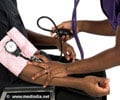One in five Americans are unaware that they are at an increased risk for high blood pressure, says recent study.

The study found the largest burden of hypertension in the southeast, the lowest prevalence in Colorado, and differences among genders, ethnic groups and geographies. But despite high prevalence of hypertension in the southeast, the region also had the highest levels of treatment, suggesting a major step forward.
The findings are published in an article titled "Prevalence, awareness, treatment, and control of hypertension in United States counties, 2001-2009" in the journal PLOS ONE.
IHME analyzed hypertension data by county, sex, and race for adults over 30 in the US from 2001 to 2009. Across US counties, the median rate of hypertension prevalence for men in 2009 was 37.6% and county-level rates ranged from 26.5% in Eagle County, Colorado, to 54.4% in Holmes County, Mississippi. For women, the median rate of hypertension prevalence in US counties in 2009 was 40.1% with 28.5% in Pitkin County, Colorado, to 57.8% in Holmes County, Mississippi.
The study also highlights the need for increased efforts to raise awareness among women about the dangers of high blood pressure and the need for prevention and treatment. Bristol Bay Borough, Alaska, was the only community of the 3,133 studied nationally where, between 2001 and 2009, the percentage of women receiving treatment had increased more than the percentage of men on treatment.
These findings build on work IHME released in 2011 and 2012 that provided county-level life expectancy estimates for the past two decades and showed that women in particular were faltering in comparison to the improvements in life expectancy seen in Europe and the high-income countries of the Pacific.
Advertisement
The study uses data from the Behavioral Risk Factor Surveillance System (BRFSS), a yearly state-level telephone survey that monitors leading risk factors for premature mortality and morbidity, and the National Health Examination and Nutrition Survey (NHANES), a nationally representative cross-sectional health survey. By applying new small area estimation methods, IHME is able to make estimates at the county-level that were not possible just five years ago.
Advertisement
- Texas had some of the highest disparities among counties in treatment levels for both men and women.
- California treatment levels below the national averages for both men and women while Florida had rates of uncontrolled hypertension for both sexes that were higher than the national averages.
- Counties in four states accounted for the 10 highest rates of hypertension prevalence—Alabama, Georgia, Louisiana, and Mississippi—but the percentage of people in those states whose hypertension was being treated or was controlled increased between 2001 and 2009.
"The message seems to be getting out in the South, where doctors are doing a good job of helping their patients control their hypertension," Dr. Mokdad said. "There's certainly room for improvement, but there have been some great success stories within particular counties."
County-level results from the study are available for download and in online data visualizations at http://www.healthmetricsandevaluation.org/tools/data-visualization/hypertension-county-and-sex-us-2001-and-2009.
In addition to geographic disparities, the study also found disparities due to gender and race. Black men and women had the highest total prevalence of hypertension, at 50.8% and 54.4%, respectively. Prevalence rates for Hispanic men were 38.1% and 42.6% for Hispanic women. The states with the largest disparity between the genders in uncontrolled hypertension were Alabama, Mississippi, Georgia, and Virginia.
Researchers noted the significant risks of uncontrolled hypertension, which kills one in six adults in the US. IHME's Global Burden of Disease 2010 study (GBD) found that in 1990 and 2010 high blood pressure ranked second as a cause of premature death for women and third for men.
"This hypertension work shows the power of a disease-burden analysis that delves into the differences within a country," said IHME Director Dr. Christopher Murray. "IHME is in a unique position to produce county-level data that communities can use to evaluate what works locally and help set priorities."
Source-Eurekalert















